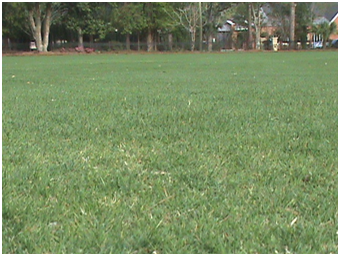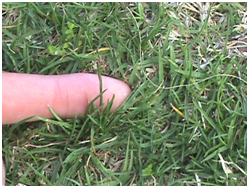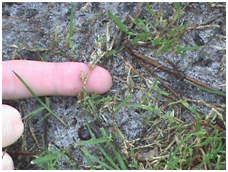Bermuda grass
Cynodon dactylon

(Photo by Phillip Rustin)
View the Location on Campus
Taxonomy (1,2)
Classification: Angiosperm, monocot
Family: Poaceae
Common name: Bermuda grass
General Information (1,2)
Region of Origin: Africa
USDA Plants Hardiness Zones: 7-10
- Size: 0.5-3 inches
Diagnostic Characteristics
Leaves

(Photo by Phillip Rustin)
Stolon (3)
- Other: Also has rhizomes

(Photo by Phillip Rustin)
Seedhead (1)
- Inflorescence type: Spikelet
Horticultural Information (1,2)
- Light: Full sun
- pH: 5.5-6.9
- Maintenance: Requires frequent mowing
- Landscape Uses: Yards and open areas
- Other: Avoid shaded areas
Interesting Facts (1,2)
- Bermuda grass is one of the few grasses that can handle dry, drought like conditions
- Bermuda grass is one of the top commodities produced in Florida.
- Growth ceases when temperatures average 50 ⁰ F.
References
1) Waltz, C. (n.d.) Georgia turf. Bermudagrass http://www.commodities.caes.uga.edu/turfgrass/georgiaturf/Turfgras/1111_Bermuda.htm. Accessed April 1, 2013.
2) Steve Dobbs (2002). The Perfect Georgia Lawn. Nashville, TN;Cool Springs Press.
3) D. W. Cudney, Botany/Plant Sciences emeritus, UC Riverside; C. L. Elmore, Veg Crops/Weed Science emeritus, UC Davis, C. E. Bell, UC IPM Pest Management Guidelines: Turfgrass. Oakland: Univ. Calif. Agric. Nat. Res. Publ. 3365-T. http://www.ipm.ucdavis.edu/PMG/PESTNOTES/pn7453.html
Edited by Jessica Bartek
Department of Biology
-
Room 2035, 2nd Floor
Bailey Science Building -
Mailing Address
1500 N. Patterson St.
Valdosta, GA 31698 - Phone: 229.333.5759
- Fax: 229.245.6585
Monday - Thursday
8:00AM until 5:30PM
Friday
8:00AM until 3:00PM
Saturday - Sunday
Office Closed